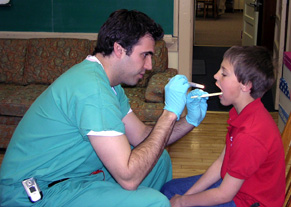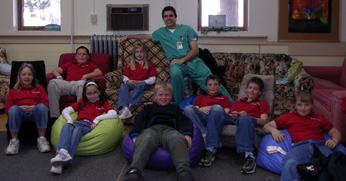 |
Greg Fought, D.D.S., examines the teeth of Benjamin Kuehn, a third-grader at St. Wenceslaus School in Dodge, Neb. Photo courtesy of the UNMC Pediatric Dental Clinic. |
In an effort to determine the prevalence of dental disease among Nebraska’s third-graders, the state Health and Human Services System, in cooperation with the UNMC pediatric dentistry residency program, conducted a dental surveillance screening at select schools across the state. Dental caries is a condition related to tooth decay.
“The purpose of the Nebraska Oral Health survey was to obtain a statewide estimate of the oral health status of third-graders,” said Jane Bennett, D.D.S., a senior resident with the UNMC pediatric dentistry residency program. “This included looking for the prevalence of untreated decay, treated decay, sealant placement and treatment urgency.”
Dr. Bennett was one of two senior dental residents who took part in collecting data for the survey. The other resident was Greg Fought, D.D.S.
 |
Greg Fought, D.D.S., and the third-grade class from St. Wenceslaus School in Dodge, Neb. Pictured are: Benjamin Kuehn, Leah Grovijohn, Trent Ortmeier, Tyler Ortmeier, MaLeaha Semerad, Marissa Semerad, Danny Widhelm and Casey Wisnieski. Photo courtesy of the UNMC Pediatric Dental Clinic. |
Dr. Fought said one of the most interesting aspects of the survey was seeing the different levels of dental care that children from different communities received. “We observed several children with active dental decay,” Dr. Fought said. “Even though we weren’t able to perform any treatment we were able to alert parents to our observations.”
As a result, the screenings provided valuable information for the survey, and for the children’s parents, Dr. Fought said. A listing of the Public Health Dental Clinic directory also was provided to children who did not have a dental provider.
“This project also helped fulfill a very important academic requirement,” Dr. Bennett said. “It allowed me to complete a research project and submit a published paper before graduation.”
After the data are collected, they will be compiled with data from other states to create a national database of the oral health status of children in the United States, Dr. Bennett said.
“Dentists can benefit from the information from this study by gaining a better understanding of the oral health condition of children in their community rather than just the patients they see in their office,” Dr. Fought said.